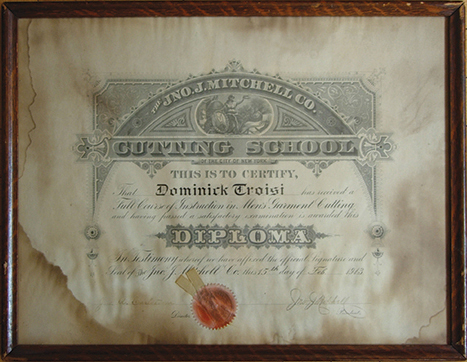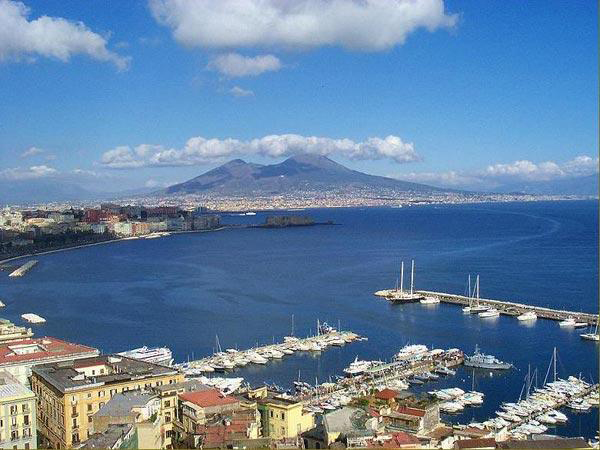This is a mash note about the New York Public Library and my uncle John A. Troisi. I adore them both.
In 1970, at age 77, on the occasion of his 50th wedding anniversary, my mother’s (and John’s) 8th-grade-educated, Italian-born father, my grandfather Domenic M. Troisi, wrote a memoir (in his second language, English) which he self-published for the family. As the family’s self-designated genealogist, I’ve been tracking down additional details of his story.
He emigrated from Naples in 1907 at age 13 and lived for 10 years in New York, before moving to Williamsport, Pennsylvania (for a job, which he secured through an interview in New York), where he married, raised his children, and remained for the rest of his life. Most family members still live in Pennsylvania, and Domenic’s early years in New York are nearly forgotten. One of several grandchildren who “came back” to New York, I have been filling in the story.
Domenic was a tailor and worked in garment factories in New York City. It’s hard to picture now, but off-the-rack garment manufacturing was one of New York’s largest industries in the early 1900s.
Domenic wrote that there was a general strike of garment workers (which I confirmed happened in January 1913), and, as shop foreman, he reported to the union hall on the first day. Impatient with wasting his time sitting around (I guess they weren’t required to picket), he left the hall to enroll in a pattern making course, which would qualify him for a job that paid better than sewing after the strike was over. We have his diploma from what he called “the Mitchell School.”
I wondered if I could find out more about the school, which has been out of business for decades, and I was successful.
Started in 1873, the trade school was reviewed favorably by both the U.S. and New York State departments of labor (in 1902 and 1908) and was respected by garment worker unions.
It was owned by the Jonathan J. Mitchell Co., which also published garment industry trade magazines (which ran advertisements for the school), sold branded tools (more ads), and ran or supported “cutters clubs” around the country, which were social organizations for graduates of the school, giving Mitchell’s people activities to report in the magazines and allowing them to keep tabs on successful graduates who might hire other graduates.
It was a soup to nuts networking operation!
Domenic also reported in his memoir that he kept up with his new trade by reading technical magazines at his “second home,” the (newly opened in 1911) New York Public Library “Technical Room.”
Question: There’s no room with that name today. How could I locate it?
Answer (from a retired librarian—thank you, thank you, Rita Bott!): Room 121, now called Local History and Genealogy. I know it well: I’ve spent hours in that room researching Domenic!

Next thought: Domenic probably read Mitchell’s magazines, having just graduated from his school, and if the library subscribed to the magazines in the 1900s, they probably still have them today.
I checked the catalog for the years I estimated Domenic was reading, and bingo, there they were: The American Tailor and Cutter.
So I called in a few issues from deep storage and phoned Uncle John: “Would you like to meet me in Room 121 of the New York Public Library and read magazines together which your father read 100 years ago?”
The immediate reply: “Yes!”
Uncle John came to the city, and cousin Mike Arney came down from the Bronx to join us in the venture.
The main content of the magazines was patterns for contemporary clothing, by staff and guest writers.
As we paged through Volume 36, No. 3 of November 1914, there was…
…a pattern by Domenic Troisi!
Nobody in the family ever knew! Domenic started his own clothing store in Williamsport in 1919, and several family members later worked in it, including John. Though John worked side-by-side with his father for more than 30 years and knew his tailoring career well, John didn’t recognize the magazine and never knew about this published pattern.I pointed out that, though bound in a set, the magazine we were handling was the library’s actual 1914 copy, not a facsimile, and Domenic probably sat in this room 100 years ago fingering these very pages to savor his accomplishment. We cried.
Here’s a video.
Thanks owed: to Mike Arney for losing sleep, literally, to join us, and for shooting the better part of the video, and to my fabulous nephew Brendan Doonan who fixed the parts I shot, which were even more terrible than what you see in the finished product, if you can imagine. (Brendan “stabilized” my shaky hands and “re-rotated” where I turned the camera vertically as if I were making a still photo—amateur.) Too bad there is no fix for my blurry focus and our stage-whisper voices (trying to not get booted out of the library), but Brendan pointed out that Uncle John’s “Holy shit!” is pretty awesome, so there’s that.









